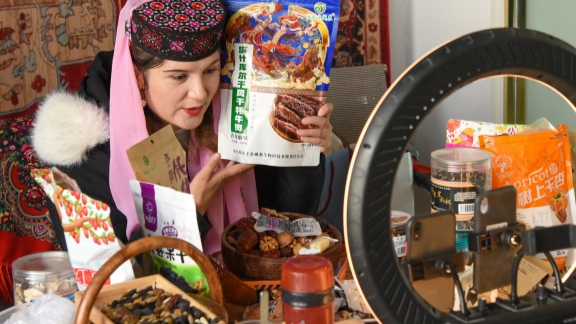[ad_1]
The Kazak ethnic group of northwest China’s Xinjiang Uygur Autonomous Region that once led a nomadic life in the pastoral areas of Suoerbasitao has now discovered newfound fortune through modern pursuits like camping, photography and livestreaming.
Muxtar, a herder from Suoerbasitao, located about 100 km from the regional capital Urumqi, has been welcoming guests since 2017, offering accommodation to visitors in his two cabins and three yurts, alongside serving traditional Kazak dishes like barbecue and milk tea.
“July is the busiest month. We receive 20 groups of guests a day and have a team of 11 people, including our relatives, dedicated to serving our visitors,” Muxtar said.
During the summer vacation, Muxtar received assistance from his 13-year-old nephew, Bahbalkan Timurhali. The young boy, who currently resides in nearby Changji City, said that he feels rejuvenated every time he is in Suoerbasitao. “I really like living in the yurt in the pasture.”
The pastoral landscape of the region also houses intriguing tales of people like Ahli, a herder with a passion for photography. Five years ago, he formed a photography team comprising 70 people, all of whom are herders. They have taken over 10,000 photos of cattle, sheep, and people with their mobile phones, documenting the nomadic life.
Tan Chengjun, a supervisor of the photography team and a member of the Photojournalist Society of China said: “For herders and me, photography means happiness!”
“Life in the pastoral areas can sometimes be monotonous, but guiding herders to capture the beauty of their surroundings with mobile phones can enhance their spiritual experiences,” said Tan. Reminiscing about an online photography competition, he said herders were so enthusiastic that they went to the extent of requesting friends and acquaintances to vote for their entries.
Nurxashi Habil, a 47-year-old herder, not only enjoys photography but also shares videos on the Internet, with most of her videos capturing the everyday life of the picturesque pastoral landscape.
She has over 100,000 followers on the video-sharing app Douyin, the Chinese version of TikTok. From late April to mid-October, it is the peak season for Nurxashi Habil to welcome guests on the lush grasslands. During this period, she is also quite busy posting new social media content.
Nurxashi Habil’s online presence has a magnetic pull on tourists, drawing them to her yurts. She shared an example, saying, “A woman came here to experience nomadic life after watching my livestream.”
Nurxashi Habil operates 13 yurts for guest accommodations and employs up to five herders to assist with her business. She compensates them with a daily wage of 100 yuan (about 13.9 US dollars) each.
[ad_2]
